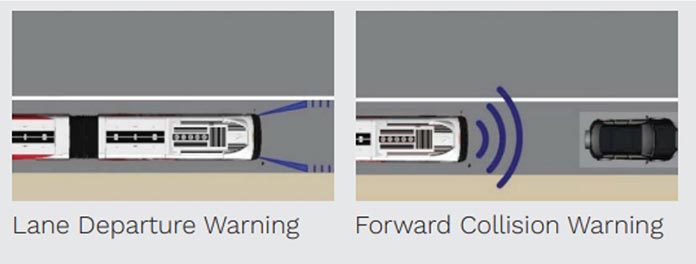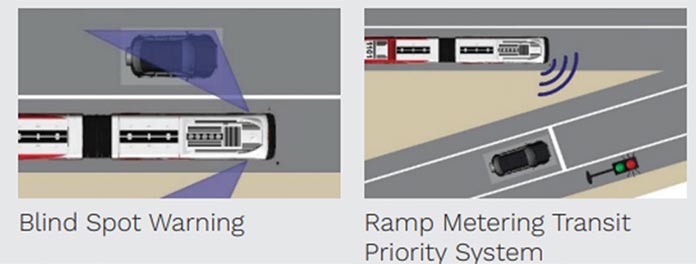The Bus on Shoulder (BOS) pilot project is here!
Riders and bus operators on the South Bay Rapid 225 will be able to put traffic in the rear view mirror as buses enter select shoulders on two freeways to bypass vehicle congestion during peak travel times.
For the next three years, riders and bus operators on the South Bay Rapid 225 will be able to put traffic in the rear view mirror as buses enter select shoulders on two freeways to bypass vehicle congestion during peak travel times.
From 6 to 9 a.m. on weekdays, buses are now able to enter the shoulders in the northbound I-805 and westbound SR 94 directions, and from 3 to 7 p.m. only on the eastbound SR 94 to southbound. This means more reliable and faster commutes!
Safety First:
Safety has been on the forefront of this project from the start, and special training for bus operators and technology play important roles:
- South Bay Rapid buses have been equipped with innovative technology to minimize any risk of accidents and assist drivers during the commute.
- MTS bus operators have been specially training to operate on the freeway shoulder alongside the California Highway Patrol.
- Buses can only enter the shoulder if travel lanes are operating under 35 miles per hour (mph) and will not exceed a maximum speed of 35 mph in the shoulder.
- Shoulders will always remain available for law enforcement, emergencies, and incident management.
Innovative Technology:
This project is the first use of vehicle-to-infrastructure technology in the San Diego region. Sensors embedded on these buses provide audio and visual alerts to bus operators regarding lane position and potential conflicts between the Rapid buses, other vehicles, or obstructions along the corridor and shoulder.
The three-year Transit Only Lane Demonstration Project allows for South Bay Rapid buses (Route 225), operated by specially trained bus operators and equipped with innovative technology, to perform Bus on Shoulder (BOS) operations along I-805 and SR 94 between Downtown San Diego and National City. South Bay Rapid buses can operate on freeway shoulders during heavy traffic congestion, helping bus operators to bypass slow traffic and maintain transit schedules.
When can buses enter the freeway shoulder?
BOS operations will be limited to weekdays from 6 to 9 a.m. in the northbound I-805 and westbound SR 94 directions, and from 3 to 7 p.m. only on the eastbound SR 94 to southbound I-805 connector. Bus drivers can only enter the shoulder if travel lanes are operating under 35 miles per hour (mph) and will not exceed a maximum speed of 35 mph. No shoulder operations will take place when the pavement is wet or during inclement weather.
Is it okay for other buses or vehicles to drive on the shoulder?
Driving on shoulders is only permitted for Rapid buses during the three-year demonstration period and emergency vehicles. South Bay Rapid buses are equipped with the technology required to safely navigate between the freeway lanes and the shoulders. MTS bus operators have also undergone extensive training, so they are prepared to drive on the shoulders.
What type of technology will be used on the buses?
This project is the first use of vehicle-to-infrastructure technology in the San Diego region. Sensors embedded on these buses provide audio and visual alerts to the drivers regarding lane position and potential conflicts between the Rapid buses, other vehicles, or obstructions along the corridor and shoulder.
What agencies are involved with the project?
The project is a partnership among San Diego Association of Governments (SANDAG), California Department of Transportation District 11 (Caltrans), San Diego Metropolitan Transit System (MTS), California Highway Patrol (CHP), Federal Transit Administration (FTA), and the U.S. Department of Transportation Federal Highway Administration (FHWA).
Will similar BOS projects be implemented in San Diego County?
The three-year demonstration period will provide valuable data and feedback from riders, commuters, bus drivers, and other stakeholders in the community. These factors will help guide discussions about potential policy considerations to support future bus on shoulder operations in San Diego County and throughout the state.
Now that Rapid 225 can operate on the shoulder, will anything else change with the route?
No. All aspects to taking Rapid 225 will remain the same. The cost will be the same. The route will be the same. It will also serve all the same stations. The only difference is the option to use the shoulder lane during peak rush hour to speed up trips.

